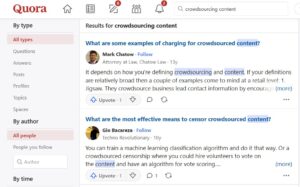Why Is Content Important?
Content is the cornerstone of communication in the digital age, encompassing a wide array of formats used to inform, engage, and inspire audiences. For a blog, content typically takes the form of written articles or posts that provide insights, tell stories, or address specific needs. But content goes far beyond words—it can also include images, videos, translations, annotations, and even user-generated insights that enrich the experience of a product, service, or platform. ‘Content’ also includes data that is used to train AI. Co-creating content through crowdsourcing really boosts valuable diversity by accessing collective intelligence.
Crowdsourcing content, of whatever variety, is a modern, collaborative approach to content creation. Instead of relying solely on internal teams, businesses can tap into their employees, customers, partners, and even the global public to co-create diverse and dynamic material. By leveraging the power of collective input, businesses gain fresh perspectives, reduce costs, and build stronger connections with their communities.
This article delves into the specifics of how businesses can crowdsource written content for blogs, collect and curate images, generate translations, and annotate data effectively.
1. Crowdsourcing Written Content to Boost Diversity
Blog writing is one of the most accessible and impactful ways to crowdsource content. There are several sub-groups of content providers.
Employees bring unique insights from within an organisation. Subject matter experts, customer service representatives, and sales teams can write articles sharing expertise, co-creating content that solves customer pain points, or highlights the company’s culture.
Customers can share their experiences or success stories which not only creates authentic, relatable content but also builds trust with your audience. Some businesses even use highly experienced customers as an extension of their Customer Service operation. People they engage with appreciate the perceived objectivity of someone who isn’t trying to close a sale or necessarily follow a company line.
Collaborating on guest posts with supply chain suppliers or vendors can offer new perspectives, particularly for B2B blogs. Their views of what a particular business is good and not so good at may not always match the views of the business’s own management team, and this can be a very insightful exercise..
Do not overlook the general public. Platforms like Medium, Quora, or even direct outreach on social media can attract talented contributors or influencers to contribute blog content.
Given the variety of brand touch points with different types of stakeholders, it is important to provide clear guidelines for each set of contributors, including tone, style, and a description of who the intended readers of the blogs are. Asking them to use collaboration tools (e.g., Google Docs, Trello) will also streamline the content development process.
The benefits of co-creating content such as blogs through crowdsourcing include harnessing a wider diversity of opinions and experiences, greater authenticity, and a greater sense of brand loyalty among the content contributors. The final benefit requires naming the contributors through author credits, or social media shoutouts.
In addition to blogging, crowdsourcing allows ordinary individuals to become key contributors to the world of news reporting. This is referred to as “citizen journalism” and can also be achieved through crowdsourcing video and still imagery content.
2. Crowdsourcing Images
Visual content is a vital complement to written material. Businesses can crowdsource images for marketing campaigns, blogs, social media, or user interfaces in several ways.
Encourage customers to share photos of themselves using your product or service on social media. User Generated Content (UGC) is excellent for use as authentic marketing materials.
Public photography contests can gather high-quality images. Reward participants with prizes or recognition to boost engagement and levels of involvement..
Community platforms like Unsplash or Dreamstime allow photographers to contribute work that can be used under specific licenses, or sometimes without any restrictions at all.

Image source: NATIX DePIN
There is a growing number of commercial service providers that are based on crowdsourced imagery, such as the NATIX DePIN which pays gig-economy workers to provide images for its geospatial platform.
Similarly, the Roamler crowdsourced store checking platform uses regular shoppers to send images of products on supermarket shelves and compiles compliancy and competitive activity reports for its clients.
Major benefits of crowdsourcing images include generating a diverse range of visuals that align with different audiences and cultures; cost reductions through avoiding expensive stock photos that are under copyright; as with written content, it can increase brand loyalty among the contributors.
To avoid wasting the time of contributors and the people who check the images that are provided it is best to define themes or prompts for contributors to avoid irrelevant submissions. Also, make sure copyright issues and rights over the subsequent use of the images are made clear at the outset.
3. Crowdsourcing Translations
For cross-border businesses, accurate translations are crucial to reaching international markets. Crowdsourcing translations is a cost-effective and community-driven alternative to professional services.
- Organizations like TED or Wikipedia rely on the collective intelligence of passionate volunteers to translate content into multiple languages.
- Companies like Facebook and Duolingo invite users to suggest and refine translations for accuracy and cultural relevance.
- Marketplace platforms like Gengo or Unbabel connect businesses with freelance translators who can scale content translation efforts.
- Commercial service providers can source content directly from their network/crowd, e.g. Neevo
Advantages of crowdsourced translations include capturing local nuances and cultural sensitivities better than automated tools; more cost-effective multilingual content production for smaller businesses; it fosters a sense of inclusion among users who contribute.
Quality control of content co-creation can be maintained through providing a clear context for the content being translated to avoid misinterpretation, and checking generated content through peer reviews or validation by professional translators.
4. Training AI through crowdsourcing data annotation and datasets
Annotations—such as tagging images, labeling datasets, or categorizing content—are critical for AI, machine learning, and search engine optimization (SEO). Crowdsourcing this task can save resources while providing high-volume, high-accuracy data.
Crowdsourcing is a useful way for training AI and deep learning models because it harnesses the collective intelligence and abilities of a large group of people. The general idea is to outsource tasks that would otherwise be performed by a small group of experts to a large group of non-experts. This can include tasks such as annotating data, collecting data, and labeling images. Relevant platforms to use for this include Mechanical Turk, Appen and Zooniverse.
The benefits of crowdsourcing for AI training include increased efficiency, reduced costs, and improved accuracy and diversity of the training data. However, there are also challenges associated with crowdsourcing, such as quality control, data privacy, and security.
Crowdsourcing datasets to train AI can also fuse artificial and human intelligence to provide a unique collective intelligence. It is acknowledged that certain tasks require human judgment or common sense that AI struggles with. Crowdsourcing allows the leverage of human intelligence for specific steps within the AI workflow.
This can be particularly useful for tasks like sentiment analysis or identifying complex patterns in data. For example, a medical diagnosis system might struggle with a rare or atypical case. Human doctors can use their experience and knowledge to consider less common possibilities.
Conclusion
Co-creating content through crowdsourcing collective intelligence is a powerful way for businesses to scale content creation, diversify perspectives, harness collective intelligence, and engage communities. From written blogs to images, translations, and annotations, crowdsourcing content of all types leverages the collective power of individuals to produce richer, more dynamic, and often more authentic material. By defining clear goals, providing guidance, and fostering collaboration, businesses can unlock a world of creative potential while building lasting connections and customer engagement with contributors.
2025 BOLD Awards VI
Boldest Crowdsourcing is one of 33 categories in the BOLD Awards for digital industries and the tech that powers them. Entries close on January 9, 2025, so don’t delay and enter now. Crowdsourcing Week is the crowdsourcing category partner, and we will be looking for platforms and initiatives that can demonstrate achievement of clear business milestones will be rewarded in this category. We will consider the approach to crowd participation, platform design and functions. Judging will not be based on size or number of users but on efficiency, ingenuity, and proven business success.
After two rounds of judging by public voting and then assessment by a panel of international experts, the finalists in each category will be invited to attend the gala dinner award ceremony on Friday March 28, 2025, in vibrant Lisbon, Portugal.





0 Comments